|
作者:Joris Dormans 引言 《大金刚》的诞生标志着宫本茂开创了一个新的电脑游戏类型——平台游戏。玩家在2D游戏世界里上蹦下跳,同时还要躲避各种陷阱和摇摆物,这成为整个八十年代至九十年代初 成功游戏的开发基础。随着3D游戏,特别是第一人称射击游戏的崛起,经典的平台游戏逐渐丧失其优势。而现在,玩家们与时俱进,平台游戏鲜有新作问世。 平台游戏以不同的方式继续存活着。许多2D平台游戏在主机、平板和智能手机上找到了繁荣滋长的土壤。然而,这种状况能维持多久,只能让时间来让证明了。即使游戏制作的技 术正在飞速发展,但我怀疑大多数平台游戏的3D化进程仍然是长路漫漫。另外,当前还存在一些复古游戏和怀旧的玩家。正是这类玩家在维持平台游戏的生命力。某些游戏杂志和 专家等认为复古游戏已经成为一个趋势。于是,经典的平台游戏又在众多老游戏中被重新挖掘。老粉丝们为了满足自己对新原创游戏的欲望,仍然在开发平台游戏。免费但非常困 难的《Eternal Daughter》就是一例。终于,平台游戏的典型动作和玩法借助某些系列游戏(游戏邦注:例如《超级马里奥》、《波斯王子》的3D化和新作开发(《古墓丽影》) ,得以留存下来。 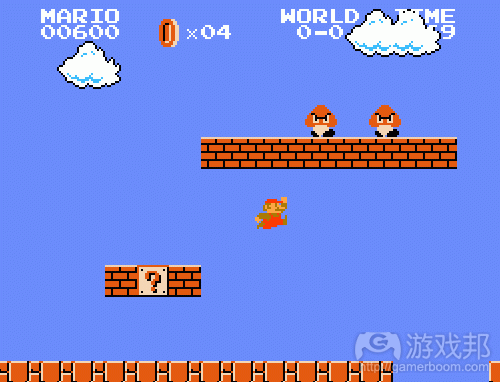 Super-Mario-Brothers(from toptenz.net)
在本文中,我将探讨2D平台游戏在其巅峰时期的魅力所在,即典型平台游戏的关键和基本元素是什么?我个人认为问题的答案应该从平台游戏的独特玩法中寻找。正是动作和限时 的动觉感观乐趣吸引着玩家不断地游戏,特别是当这种乐趣与关卡的设计和基于典型的探索的剧情紧密结合时。 游戏玩法 在我们开始分析平台游戏之前,我们必须明确游戏玩法这个复杂的概念。大多数玩家都可以证明玩法是任何游戏的决定性元素。一款游戏即使在音效和画面都非常棒,但如果玩法 上不过关,那么它还是很难受到玩家的欢迎。不过,什么是游戏玩法所必需的,则更难以确定。 在《Rules of Play》一书中,Katie Salen 和Eric Zimmerman将游戏玩法定义为“是一种形式化的交互作用,产生前提是玩家遵守游戏规则,且在游戏中体验系统。”这个定义包 含了三个重要方面:1)玩法是介于玩家与游戏之间的交互作用;2)它是形式化的,且遵循游戏规则;3)它是通过游戏而获得的体验。大多数关于游戏和游戏玩法的解释都认可它 是一种交互作用。事实上,交互作用常常被认为是游戏的定义之一。方面2)大概不那么显著,但自Johan Huizinga(游戏邦注:Johan Huizinga是荷兰的历史和文化学家)在其著 作《游戏的人》(Homo Ludens)中讨论游戏在文化和社会中的重要作用,它就变得重要了。一方面,它与“游戏性态度”,即玩家自愿服从约束其完成游戏的方法的一系列规则; 另一方面,它暗含其是一种可设计的东西。最后,游戏玩法是游戏的主观体验。这大概是“游戏玩法”这一术语令人迷惑不解的原因,因为玩家的品味和技术各不相同,要为他们 设计主观的游戏体验是很困难的。 游戏玩法不仅是一种主观体验,还受到品质的影响。一定程度上,所有游戏都有游戏玩法,但并非所有游戏都有良好的游戏玩法。优秀的游戏玩法常常能在游戏中的众多元素中取 得微妙平衡。在《the Art of Computer Game 》一书中,游戏设计师Chris Crawford将游戏玩法、游戏的节奏和学会玩该游戏所需要的认知努力联系在一起。快节奏的游戏应该减 少认知投入精力,而慢节奏的游戏可以要求玩家付出更多的认知投入精力。在这两方面实现平衡的游戏可以说具备了良好的游戏玩法。Doug Church在某篇文章中强调了控制和连贯 的重要性。他以《超级马里奥64》为例阐明了这一观点。在游戏中,设计师“给予非常有限的动作”但又完全满足游戏需要,从而使玩家获得控制感。 控制方式是区别日本游戏设计和欧美游戏设计的一个重要方面。这一观点贯穿Kohler的《Power Up》全书,也被许多游戏设计师所强调。宫本茂如此解释:“如果游戏操控方式没 有乐趣,那么画面、音效、甚至角色和剧情都是毫无意义的。”日本和欧美游戏的设计差别在很大程度上是由早期日本和欧美游戏所欣赏的文化背景造成的。欧美游戏行业吸引的 是工程师、电脑专家和商人,而日本游戏设计师往往具有美术方面的背景。宫体茂持有工业设计学位,抱着设计玩具的想法供职于任天堂。在他进入游戏设计领域之前,他曾参与 一些公司的初期电子游戏设计项目。当他着手《大金刚》之时,他还没有真正的设计经验。 日本设计师对游戏设计观念与欧美同行们是不同的,相比之下,他们更关注玩家和游戏之间的交互作用,这种敏锐的洞察力与欧美设计师偏重游戏设计技术是大大相反的。日本出 身的设计师Dylan Cuthbert将其总结为:“我们想要高超的技术,但我们更关注游戏的品质。我们希望玩家玩得开心,不是为我们或者设计师,而是为他们能努力实现设计技巧得 到快乐。”日本游戏的成功在于围绕一个小的想法或动作来设计游戏,如《口袋妖怪》的设计师田尻智解释道:《吃豆人》是围绕“吃”这个动作设计的,而《口袋妖怪》则是“ 驯服”。与此类似,马里奥当然是“跳”。 显然,设计早期的平台游戏的玩法需要付出大量努力。但是,单凭这种努力并不能解释这类游戏的成功。为了搞清这点,我们必须理解由运动、定时和探索这三者之间的特殊平衡 所组成的游戏玩法。我们还必须回答这个问题——为什么跳起来踩死敌人就那么好玩? 像马里奥一样思考 你抓着控制器,精力一恢复,你就完成了新关卡的初期阶段。敌人很快就登场了,你轻松到达门口。在拱廊这,你折腾了好一阵子。打倒第一关的BOSS已经够了难了,结果这里上 蹿下跳的飞头来得还这么多这么快。没有时间琢磨它们的运动路径,更别说打中它们了。你冲过去,左躲右闪,想跳过它们。没用,你一次又一次地撞上这又快又难躲的东西。但 之后你发现走道有一个点是安全的。此时你的体力所剩无几,你终于明白,如果你从一根柱子跳到另一根柱子,就能避开它们的路径了。恍然大悟之后,你突然就很轻松地闯到楼 梯处了。你登上台阶,却发现更多飞头在等着你,它们的飞行路径跟刚才的又不一样了,你却来不及分析了。 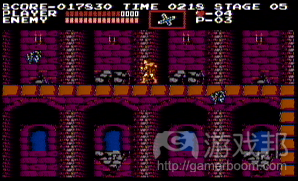 恶魔城(from jorisdormans.nl)
以上说的正是《恶魔城》的简要游戏过程(图1)。由此我们可以看到平台游戏吸引人的地方。首先,玩平台游戏是一个化身感很强的过程。许多游戏的本质就是沉浸感和代入感, 当它用于屏幕上的角色或投射到游戏世界中,就成了吸引玩家的临场感。也就是,玩家不只是在玩游戏,还获得一种亲临其境的感觉,在游戏世界里,你占据了虚拟空间的一个主 体。这个效果在现代3D游戏中表现得最为显著,因为玩家能看到的角身所处的游戏世界。玩家所处的空间与角色一致。不过,在所谓的第三人称平台游戏中,玩家可以在屏幕上看 到角色,那种感觉就要弱一些了。为了完成这些游戏,我们必须指挥我们的角色避开各种陷阱、通过重重关卡。玩家对角色的认同感一般相当强烈。 并非所有的游戏都能带来这种强烈的化身感。Friedman这样描述玩家与策略和模拟游戏的交互作用:玩家必须同时与整个系统产生直接的交互作用。这种交互作用是无实体的,玩 家能直接感知游戏所提供的信息,几乎好像那本来就是玩家大脑或身体的控制延伸。“像电脑一样学习思考”是Friedman形容游戏的超验感,即抛开本体,达到一种对游戏模拟和 深层结构的控制意识。 平台游戏的化身并不一定意味着人本身的表现。事实上,这种情况极少发生。马里奥拥有超人的能力和精力,可以在平台上跳来跳去。他最喜欢的杀敌方式就是跳到敌人头上,但 这跟真实的人类生理机能没有什么关系。学会这样控制身体相当于在战略游戏的虚无感中与“其他东西”接触,但这种虚无感的乐趣来自其要求玩家具备的超验感,而实体体验的 乐趣则是运动感官性的。正是乐趣和控制感和成就感,再加上一系列执行良好的动作,使得玩平台游戏变得趣味无穷。跳死乌龟和甲虫之所以有趣,是因为这个杀敌方式需要玩家 通过计算机空间来充分发挥受控身体的优势。 然而,平台游戏并非带来纯粹的化身体验。优秀的平台游戏的关卡同时也给玩家出谜题,角色及其活动是解答的关键。就我们所知道的角色,玩家的外在观点常常有助于设计和分 析游戏中的关卡。以《恶魔城》为例,安全地点恰好与走道上的柱子一致的情况并非巧合。为玩家提供躲避飞头难题的线索是有设计意图的。平台游戏广泛运用这种类型的暗示和 线索。学会识别关卡中的符号系统,对于通关成功是非常重要的。学会“像马里奥一样思考”就是是掌握游戏世界的自然法则,掌控角色以及理解此二者如何产生交互作用。 流程 Victor Nicollet详细说明了玩家在平台关卡中遭遇的不同类型的障碍。即: 陷阱:这是指需要玩家用技术和操作来避开的地形特征。最简单的例子就是,两个平台之间的空隙。陷阱不会发生变化,只需要一点点操作就能通过。 摇摆物:这类障碍需要捏准一定的时间间隔才能安全通过。其实就是在陷阱的基础上增加了时限因素。 不稳定地面:这类障碍的安全只能维持一小段时间,这迫使玩家必须快速通过。  Donkey Kong Country 2(from jorisdormans.nl)
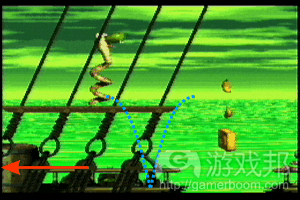 跳过木桶(from jorisdormans.nl)
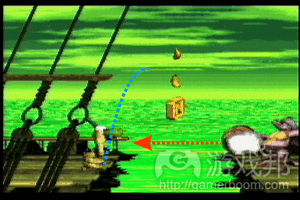 上岸(from jorisdormans)
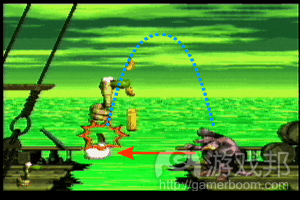 在缓慢的木桶上(from jorisdormans)
 踩在鳄鱼上(from jorisdormans)
以上三类可以组合成复杂的关卡模式和难度渐增的障碍。图2-6所示游戏过程选自《Donkey Konk Country 2》中的“Rattle Battle”关卡。从中可见这种模式集合了这三类障碍的 所有元素。角色(左边的蛇)必须在固定的间隔时间内避开射向它的木桶(摇摆物,图2和图3),并且跳上一个马上就会被破坏掉的木桶(不稳定地面,图5)才能跃过间隙(陷阱 ,图4-6),最后跳上正朝着角色发射木桶的鳄鱼(可以看作是陷阱,图6)。 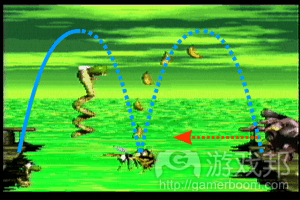 一个相似的序列(from jorisdormans.nl)
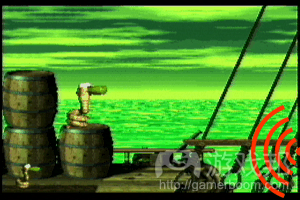 声音提示开始(from jorisdormans)
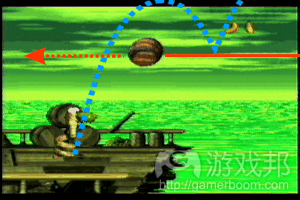 最后序列(from jorisdormans.nl)
 关卡的最后胜利(from jorisdormans.nl)
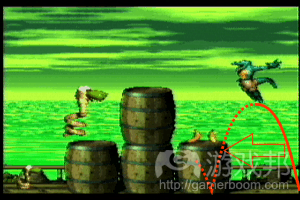 在鳄鱼上跳过并前进(from jorisdormans)
要通过这些障碍需要一定的练习,但是,一旦玩家发现只需要跳上木桶就能跃过间隙,算好最佳起跳时间,那么这一系列动作也就相对容易完成了。这是出现在相同关卡中的三个 难题中的第一个。第二个难题要求玩家躲开大炮球(不能当作跳板),然后跳上一只飞舞在间隙上方的蜜蜂(图7)。技巧就是从一个玩家看不到火球但听得到发射声音的固定点开 始连续的跳跃动作,开始跳向障碍的同时,新的发射也在进行(图8)。最后一个障碍要求玩家执行一个高技巧的跳跃动作,即跳过木桶后马上又跳起来击败鳄鱼(图9和图10)。 注意最佳的起跳点是以背景上的几个木桶作标记的,而玩家必须击中木桶的地方是用香蕉所在方位作标记的。 Nicolette并没有在文中讨论敌方角色。许多敌人的行动就相当于陷阱、摇摆物、不稳定地面或这三者的组合。图7中的蜜蜂所起的作用就是不稳定地面。鳄鱼枪手制造摇摆物的同 时也起到陷阱的作用。有些敌人要求玩家执行更复杂的动作,如前进、跳过鳄鱼(图11)。玩家如果能跳到鳄鱼头上就能消灭它们,否则就是反被消灭。因此,鳄鱼就相当于摇摆 物:当它们在高空时就是危险的,当它们接近地面时就可以被击败或避开。因为它们也朝玩家移动,玩家没有时间想出击败它们的正确节奏。 在其他平台游戏中,敌人还有更复杂和偶尔自主的行为,或者游戏本身引入不同的玩法。例如,《波斯王子》中的守卫。玩家与之进行的决斗就不能当作陷阱、摇摆物或不稳定地 面理解。又例如,《奇异世界之阿比逃亡记》(图13)中可以发现大量行为不限于固定模式的敌人。玩家无法通过针对敌人的行为快速执行正确的动作来消灭他们。在早期的游戏 中,玩家还要为关卡BOSS战保留某类动作。 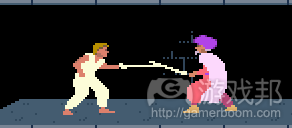 《波斯王子》(from jorisdormans)
 《奇异世界》(from jorisdormans)
但是,玩家仍然必须掌握角色的操作才能克服固定且可预测的障碍和自主敌人。玩家甚至必须能够执行精确到1像素的跳跃动作。随着障碍的增加,玩家执行一系列动作的压力也随 之增加,如此,关卡就提高了对玩家的灵敏度和定时能力的考验难度。事实上,有人可能会说设计良好的平台游戏对玩家的训练,可不像训练武术学生。越早越简单的关卡允许玩 家用基本的动作技巧做实验。在玩家需要在重复的套路中执行某个动作以前,玩家有机会用基本功磨练自己的能力。 从《大金刚2》的截图中我们可以看到跳跃动作如何转变为控制和定时能力,最后变为节奏。这类顺序为玩家与敌人的更开放性战斗做准备。在接下来的阶段,敌人的行动变得更加 难以预测,特别是各个关卡的BOSS。 Chris Kohler在探讨《五轮书》(游戏邦注:此书是日本剑圣宫本武藏所著的一本既是剑法,同时也是兵法的一本著作。)中的“流”这个概念时(游戏邦注:读者不妨把这个“ 流”抽象的概念当作“节奏”来理解),还简要地描述了游戏和武术及其哲学的关系。“流”是沉浸的关键因素,相当于“完满的美学体验”,是一种或多或少改变了的感觉状态 ,在这种状态下,运动与游戏中的其他元素紧密结合。在这个阶段,玩家的运动体验几乎都是身体性的,这就解释了执行一系列跳死敌人的动作为什么能给玩家带来运动感官上的 兴奋。“流”状态还与Roger Caillois的“游戏的四个基本范畴”中的“晕眩”有关。这个范畴的定义是“游戏时伴随着晕眩的感觉”。这样理解时,许多游戏类型似乎都与之无 关,但若把“晕眩”的概念拓展到“对速度的晕眩”和上文所述的身体感觉,“晕眩”对了游戏乐趣的描述又比“竞争”、“机会”和“模拟”这另外三个范畴的要恰当。 发现 上文所述的“流”并非平台游戏的专利。与武术的关系使它在格斗游戏中也表现得很突出。然而,平台游戏将“流”与另一个重要元素“发现”相给合了。平台游戏还是关于探索 的游戏。游戏的目标不是积分或创新纪录,也不是打败尽量多的敌人,而是通关到底。玩家要发现并解决平台游戏中的谜题,才能进入下一个关卡。在这一节内容,我将探讨平台 游戏的“发现”元素。 最初,平台游戏的关卡画面的大小与电脑屏幕相当,不过这些游戏通常都有数道关卡。随着横板游戏(如《超级马里奥兄弟》和《Eternal Daughter》)以及单一关卡由多张静态 画面组合而成的游戏的出现,游戏的容量巨增。这也导致了积分和保存概念的引入,而设计师又因为这两个概念得以增加游戏的难度。多出口型关卡的出现使非线性游戏玩法成为 可能。其他游戏需要玩家返回或重新探索之前的关卡,这就为关卡的设计和玩法增加了新层次。玩家探索游戏世界的同时也使自己熟悉它。玩家发现游戏世界中的许多秘密,并学 会如何读取它的信息,从而为解开更复杂的谜题作准备,还帮助玩家找到更隐蔽但更重要的资源。  《波斯王子》第一关地图(from jorisdormans)
《波斯王子》中的第一关地图。该游戏非横版,所以玩家从一个画面移动到下一个画面时,背景保持静止。如图所示,这些画面已用虚线分割并标上序号。 组成关卡和促进发现的元素可以分成四个基本类别:秘密、测试、触发和谜语。我将从《波斯王子》中举例说明这些类别。大部分例子出自游戏的第1关,如图14所示。 秘密:通常是隐蔽的通道或资源,玩家很难看到或根本看不到。在简单的迷宫中,需要玩家去发现的秘密是通关的路线。通常,并不是所有秘密都必须得到解决才能通关。秘密通 常用来隐藏某些简化通关过程的资源,或帮助好奇心重的玩家更快更容易地通过困难或冗长的部分。 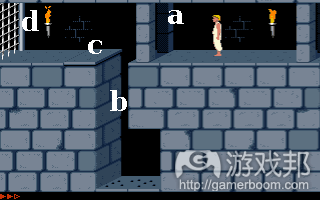 5简单的秘密、测试和触发(from-jorisdormans)
在《波斯王子》的第1关中可以找到一个简单的秘密(图15)。柱子之间有一个不稳定的薄层,玩家可以跳下去毁掉它,这样就打开了拿到治疗药水的新通道(图16)。 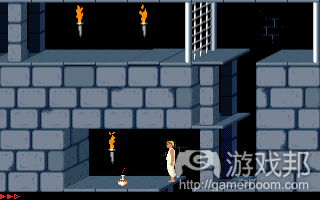 隐藏药水(from-jorisdormans)
这个新通道是不太容易发现的,因为这层路面与左右两边的石板差别很小。玩家可以从其他位置发现这里,跳下去,这样地面就会发生轻微晃动(图17)。 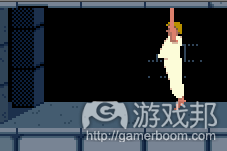 玩家跳进天花板可发现秘密(from-jorisdormans)
考验:通过制造某些难以抵达的地方来挑战玩家的控制能力。考验由上文中提到的障碍组成,包括敌方角色。在早期的技术导向型平台游戏中,考验是主导元素,但所有平台游戏 都或多或不地运用了考验。玩家不必完成所有考验,有时候考验只是奖励玩家某些额外资源。 图15中的陷阱是一个简单的考验,玩家必须通过它才能继续闯关。《波斯王子》中到处是考验玩家的木栅和死亡陷阱,还要玩家执行更复杂的跳跃动作和躲避各种敌人。 触发器:当玩家激活触发器时,新的通道就打开了,但这通常要求玩家探索相同的地方两次。例如,有一种特殊的触发器要求玩这收集打开通道的钥匙。 图15中的地砖(c)就是打开大门(d)的触发器。玩家踩上去就可以激活它。在《波斯王子》中,触发器是定时的,也就是说,大门打开几秒钟后又关闭了,并且触发器不总是在 大门附近。这种设定增加了触发器与大门之间的障碍的难度,往往让玩家产生压力,担心不能及时赶到大门处。 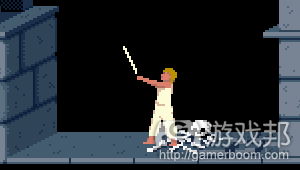 玩家必须收集宝剑(from-jorisdormans)
《波斯王子》中没有钥匙,但宝剑的作用相当于钥匙。为了打败图16中的守卫,玩家必须收集画面9(图18和图19)中的宝剑。这要求玩家重复两次从画面9跑到画面16:一次是跑 向宝剑,另一次是跑向出口(除非玩家改走从画面2到6的秘密路线)。 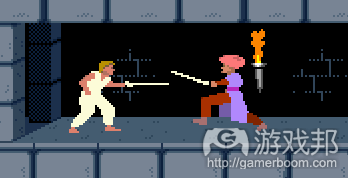 打败守着出口的敌人(from-jorisdormans)
谜语:是一些没有立即出现答案的问题或谜题,但有线索可寻。在整个《波斯王子》中,只有一个真正的谜题,贯穿了数道关卡。在第4关,玩家被一个神秘的镜子挡住了(图19) ,只有跳进镜子才能通过。但这样就释放了玩家的“镜象”(图20)。这个镜象阻碍了玩家一段时间。在第5关,“镜象”偷走了能给玩家增加命值的药水(图21),在第6关,阻 挡玩家迫使其返回地下城(图22)。在最后一关,玩家与“镜象”决斗,面对所有敌人,立即拔剑而出(图23)。然而,玩家无法打败“镜象”,反而伤害了自己。解决办法是玩 家放弃自己的宝剑,这样他的“镜象”也会这么做,再然后,玩家就与之合体了(图25)。这个办法是独一无二的(这种方法不适用于其他任何敌人),玩家必须联想到自己正在 与镜中的自己战斗。 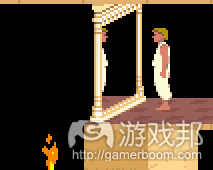 在第4关时出现了一面奇怪的镜子(from-jorisdromans)
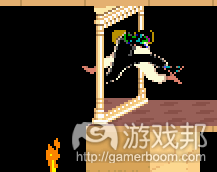 但玩家可以穿过镜子,从而释放“镜象(from jorisdormans)
相比于动作导向型游戏(如《波斯王子》),谜题在冒险或剧情导向型游戏中更常见。谜题少见,部分解释了为什么时候它总是被当作特殊情况来处理。谜题的设计成本高,因为 必须独立编程,很费时间,也浪费宝贵的磁盘空间(对老一代游戏而言)。从基本元素开始设计的关卡如果能预定程序,就会更有效率。但谜题确实为游戏增加了许多趣味,《波 斯王子》的“镜象”就是一个经典的例子。 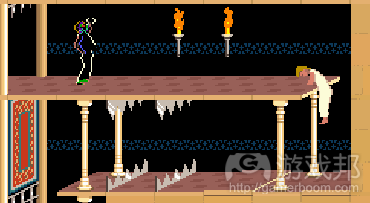 玩家还没拿到,“镜象”就喝掉了药水(from jorisdormans)
 用门挡住玩家的路(from jorisdormans)
另外,这些基本类别常常组合使用,以设计不同的、复杂的关卡。我们已经看见其中一个与宝剑结合当作触发器或钥匙,是玩家打败守卫的关键,也是第1关的核心设计。第1关的 秘密通道由除画面1到6以外的组成,是最重要的一部分。玩家可以摧毁连接画面10到画面2之间的不稳定地面以打开秘密通道,当然,还要跳过画面2中的长钉地面和打败画面5的守 卫。玩家得到的最重要的暗示是,从画面9爬到画面1.在这个画面中,玩家可以看到通道,但不能抵达(图26)。药水所在的位置是用来激励玩家找到这个通道。最后,还有相对容 易找到的几段通道在下面(画面18到20和画面21到22),但在那些通道中能找到的药水只有一瓶。《波斯王子》中的第1关比较简单,且只有一个出口。事实上,该游戏的整个玩法 都极其明确。其他关卡中都没有第1关中的秘密通道。尽管谜题和考验越来越难,但《波斯王子》让玩家提前看到关卡的某些部分,这一点做得很好,这是奖励那些注意关卡布局和
设计的玩家。 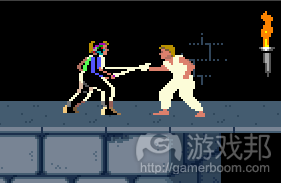 与玩家对决,但玩家打不赢他(from jorisdormans)
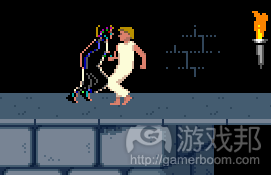 “镜象”与玩家重聚(from jorisdormans)
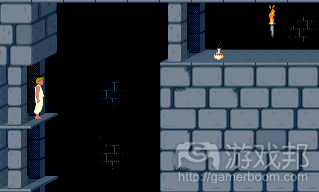 玩家可以看到药水,所以一定有办法拿到(from jorisdormans)
 最后一幕,王子救到了公主(from jorisdormans)
平台游戏的关卡也可以相当复杂。关卡可以有多个出品,数个秘密部分,或者游戏可以微调整关卡后要求玩家再次探索。每一次玩家(再)探索关卡时,就可以发现新的秘密、游 览新的场景、掌握新的技能。在平台游戏的世界中旅行本身可以是一种乐趣,这不同于现实世界中的旅行。Maaike Lauwaert认为,这种源于发现和进展的玩法和乐趣有足够的理由 在Rogor Caillois的玩法维度中增加第五个元素:重复的惊喜。重复不同于机会,因为只有游戏水平高的玩家才能感受并利用它的益处。 超越 流和发现这两个方面有一个共同特点:包含学习曲线。随着游戏进展,考验变得越来越难,发现秘密和解决谜题也变得越来越重要。游戏的末尾更是得逼玩家使出所有招数。设计 良好的游戏会充分利用双重学习曲线来增加关卡和设计的深度。特别是当游戏将双重学习曲线与某些剧情发展和或任务相关联时。大多数平台游戏都为角色提供了作为目标的剧情 元素。一般来说,剧情元素是以基本任务的形式呈现的。比如,游戏中总有数不尽的公主等着角色去拯救(《波斯王子》走的就是这条线路,如图27所示)。这种任务的剧情框架 实在是很方便,因为它直接明了,经典的童话套路非常适合主人公克服千难万阻的线性玩法。但任务的明确性也可能具有欺骗性,其结构也往往名不符实地被当作是一种简单的剧 情叙述形式。 Joseph Campbell也将任务剧情的精粹描述为主角的心灵成长史。通过克服艰难险阻,任务的主角得到成长,渐渐知道自己在生活中所扮演的角色、所占据的位置。这部分与主角的 心智的成熟也有关。一开始,主角通常是个不谙世事的少年(Campbell的游戏的主角几乎都是男的),历经千锤百炼后,他终于发现自己的人生使命。尽管Campbell的完整的英雄 成长史还包括主角停留在冒险的领域和最后回归正常的生活,游戏任务还是偏爱主角受考验的部分。显然,可以很轻松地解释为什么时候将考验放进游戏中,部分是因为游戏受众 的平均年龄层次。但是,如果能够将更多不同的成长阶段也放时游戏中,应该会很有趣。 毫无疑问,在游戏任务中主角必然会救到公主。没有必要设计一种相同的任务却带有不同结局的“交互式剧情”。最好把设计的精力放在主角如何完成任务以及如何促进不同的游 戏体验。比如,接受考验时,玩家能学到什么、如何成长?任务剧情最终是一个超越的过程,所以,游戏如果能反映并包含成长,才会更有趣。 角色的成长并非游戏的共同特征。角色的成长会直接从各种数值(如力量、敏捷或灵力)的增加上反映出来,玩家要完成游戏通常需要角色成长到一定程度。这种或类似的机制源 自“角色扮演游戏”,后者早已引入能够反映角色经历和力量的复杂系统,而“角色扮演”这个标签意味着数值导向的“角色养成”。平台游戏通常会为这类成长提供不同选择。 宫本茂强烈主张这一观点。他曾表示非常不喜欢角色扮演游戏,而努力创造一种游戏,让“玩家本身可以得到成长”。他的许多游戏中,关卡设计首先包含成长,玩家必须依靠不 断提高的角色操作水平。因此,成长不是“反映”或者直接“模仿”,而是成为游戏玩法本身的一个方面。如果成长反映在游戏中,那么其本身是作为一种新力量的主要形式,会 直接影响玩法,而不同于例如力量或敏捷这些抽象概念。有时候,这个过程会被打断,如给予玩家新的控制角色(比如《Donkey Kong Island 2》中的“Rattle Battle”关卡)。 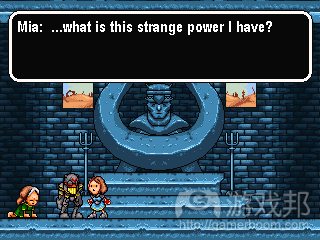 Mia渐渐发现她的力量(from jorisdormans)
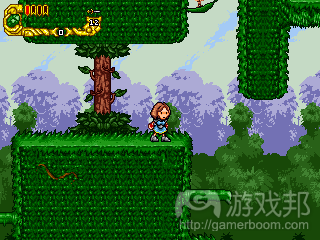 Lorain森林中有秘密通道,但只有Mia学会如何“跳墙”后,她才能取得某些重要
《Eternal Daughteris》就很好地利用了这类成长。在游戏中,玩家操作Mia,这个小女孩打算复原被恶魔Dungaga统治的世界。游戏一开始,玩家就清楚地知道Mia和她神秘的父亲 同样具有某种力量(图28)。整个游戏中,Mia的体力和力量不断增长。这可以从生命值和攻击力上看出来,另外,Mia在旅程中发现的特殊武器和动作也反映了这一点。正如剧情 所述,Mia从单纯无知的人类女孩成长为惩恶扬善的伟大女性。 《Eternal Daughteris》巧妙地利用关卡,确保玩家“故地重游”数次。许多关卡都有多个出口,有些任务可以按非线性顺序完成。所以从一个关卡到另一个关卡的旅行,以及找 到所有出口是该游戏的重要部分。此外,从各个任务中获得的力量让Mia学会新的动作,使她能到达之前不可能去的地方。她学会如何“二连跳”(游戏邦注:即跳到半空中后再次 起跳)、“跳墙”(即跳到墙面后再次起跳)和滑跳(这一招对小洞最管用)。如果是在旧关卡中使用这些动作,玩家不会发现新的秘密。例如,在游戏早期,也就是Mia刚到达 Lorain森林时,那里有一条路是她最初不能抵达的(图29)。只有在她学会“跳墙”后,她才能获得那条路上的东西。 在《Eternal Daughteris》中,超人的控制和流、电脑操控的身体和神奇世界的发现,都说明了该游戏的任务与玩法有直接关系。这是平台游戏的玩法登峰造极的代表。玩家和Mia 的旅程相辅相成,都是英雄角色的成长史。任务一个一个地完成了,重要的不是最终拯救了世界,而是拯救世界的过程。因为一同旅行,玩家与Mia遭遇形形色色的人物,看见各种 奇观异景。他们学会使用自己的力量,在这个过程中,他们已经各自成长为更出色的女性和更优秀的玩家。谁知道呢,也许除了精确定时的能力和对幻想世界的理解,玩家还学会 了其他东西…… 今天的平台游戏 随着九十年代的第一人称射击游戏的出现,2D平台游戏慢慢淡出人们的视线,但平台游戏的玩法仍然存在。2D平台游戏的3D后代,如《古墓丽影》和最新发行的《波斯王子》都非 常成功,但在我看来,它们少了某种品质。也许是在这些游戏中,操作、发现和任务的组合并不理想。比如,劳拉·克罗夫特极其难操作,导致“流”概念在游戏中的缺失。大多 数3D平台游戏都很难保持相对抽象的玩法和第一人称射击游戏所确立的现实标准之间平衡。 第一人称射击游戏本身的构成基础也是这些元素的类似组合。有些甚至直接继承自平台游戏(例如《Duke Nuke》),在各种元素的组合中,操作、发现和任务的有效组合显然是最 好的。 找到《半条命》中装弹的正确节奏、《雷神之锤》中的火箭跳,在《Deus Exare》中按照所选角色来培养机械人,这些仅是小部分例子。然而,这些没有2D平台游戏的幻想 和多彩世界的新游戏剧情叙述却开始追随一般的好莱坞科幻片的惯用叙述方式。结果,它们在2D平台游戏中非常有趣的一个方面,即任务与玩法相结合的特点却没有得到发展。 相关拓展阅读:篇目1,篇目2(本文由游戏邦编译,转载请注明来源,或咨询微信zhengjintiao) The Art of Jumpin Joris Dormans, November 2005 Introduction When Shigeru Miyamoto designed Donkey Kong he invented a new genre of computer games. The platform game where the player jumps around a two dimensional game world, dodging various pits and pendulums, became a recipe one which many successful games were based throughout the eighties and early nineties. With the rise of 3D games in general and the first person shooter genre in particular, the classic platform game has lost its edge. Gamers have moved on, and the release of new platform games is a rare occasion, these days. Still, the genre lives on in many ways. A lot of games on mobile consoles, PDAs and smart phones are still 2D, and the platform genre thrives on these gadgets. However, how long this is to be remains to be seen. The technology of is making giant strides forward and I doubt it will take long before most of these games have also moved to 3D. Next, there are the retro-games and retro-gamers, who keep the genre alive. Retro-gaming has become a trend that is recognised by gaming magazines and scholars alike. The classic platform games are one of many game genres that are being rediscovered. Old school fans still produce platform games in order satisfy their appetite for new and original titles. The freely available (and fiendishly difficult) game Eternal Daughter is an example of this. Finally the typical action and gameplay of platform games lives on as some series have made a successful move into the 3D area (Super Mario, Prince of Persia) and has spawn new series (Tomb Raider). In this article I will investigate the popular appeal of the 2D platform game during the genre’s heyday. What are critical and essential elements of the typical platform game? It is my view that the answer must be looked for in the particular blend of platform gameplay. I think the kinaesthetic pleasure of movement and timing is what enthrals the player to keep on playing and keep on coming back, especially when this is tied in closely with the design of the levels and a form of storytelling that builds on the arch-typical quest. Gameplay Before we can proceed to analyse platform games we need to define the ever elusive notion of gameplay. As most gamers will testify gameplay is a crucial element of any game. A game can look and sound fantastic, with out half-decent gameplay, it will still be poorly received. Yet, what this gameplay entails is more difficult to pin down. In Rules of Play Katie Salen and Eric Zimmerman define gameplay as “the formalized interaction that occurs when players follow the rules of a game and experience its system through play” (2004: 303). Three elements in this definition are essential: 1) gameplay is an interaction between player and game, 2) it is formalised and follows rules, and 3) it is an experience through play. Most accounts of games and gameplay acknowledge the interaction (1); in fact interaction is often postulated as one of the defining aspects of games. The fact that this interaction is formalised and follows rules (2) is perhaps less obvious, but has been on the map since the writings of Johan Huizinga. It is on the one hand related to the “lusory attitude”, the gamer’s voluntary submission to a set of rules that effectively limit her means for reaching an end (ibid. 97) and, on the other hand, implies that it something that can be designed. Finally, gameplay is the subjective experience of play. This is what probably makes the term so illusive, for it is hard to design this subjective experience for players whose tastes and skills vary. Gameplay is not only a subjective experience, it is also subjected to strong sentiments about quality. To a certain extend, all games have gameplay, but not all games have good gameplay. Good gameplay is often a subtle balance to many factors in a game. In The Art of Computer Game Design Chris Crawford associates gameplay with game’s pace and the cognitive effort required by playing. A fast-paced game should not require to much cognitive effort, while a slow-paced game can ask more difficult decisions of the player. Games that strike a good balance between these two are said to contain good gameplay (1983: 21-22). In a Gamasutra article Doug Church (1999) stresses the importance of control and coherence. He illustrates this with a discussion of Super Mario 64 in which the player is given a sense of control by “offering a very limited set of actions, but supporting them completely”. Control is also one of the magic ingredients that sets Japanese game design apart from Western game design in Power Up (Kohler, 2005). It is a point that returns throughout the book and is stressed by many game designers. Miyamoto is paraphrased to say: “Graphics, music, even characters and story mean little, if play control isn’t interesting and fun” (Kohler 2005: 273). The difference in Japanese and Western design philosophies is largely attributed to the difference in cultural status that early games enjoyed in Japan and the West. While the Western game business attracted engineers, computer scientist and businessmen, the Japanese designers often had artistic backgrounds. Miyamoto holds a degree in Industrial Design and came to Nintendo with the idea of designing toys. Before he started designing games he had worked on the case design of some of the companies earlier electronic games. When he started working on Donkey Kong he had no real programming experience (ibid: 26-35). Japanese designers brought a different mentality to game design than their Western counterparts, a lot of attention was paid to the interaction of the user with the game. This eye for detail is in stark contrast with the Western pre-occupation with the technical side of designing games. Japanese based designer Dylan Cuthbert sums it up: “We want the good technology, but we really want the game to be quality. We want the player to be happy, not for us, the designers, to be amused by pulling off programming tricks” (quoted in ibid. 180). The Japanese successes are focused games that were designed around a simple idea, or verb as Pokémon’s designer Satoshi Tajiri explains: Pac-man is designed around the verb ‘to eat’ and Pokémon around the verb to trade (ibid: 240). Likewise, Mario games are, of course, designed around the verb to jump. Clearly, a large effort was made while designing the gameplay of those early platform games. But this effort alone does not explain the success of the genre. To understand that we need to understand the peculiar balance of movement, timing and exploration that makes up the gameplay. We need to answer the question why it is fun to defeat you enemies by jumping on them? Figure 1 Dodging flying heads in Castlevania Thinking like Mario You grasp the controller with renewed vigour as the as you make your way through the initial stages of the new level. The opponents are quickly disposed and you reach the door with ease. Now comes the arched hallway that has eluded you for a while. Getting past the first level’s boss is already hard enough, but these flying heads that dance up and down in sinus patterns are to fast, and too many. There is little time to anticipate their trajectories and let alone to try and hit them with you whip. You rush in, dodging left and right, occasionally trying to jump over them. To no avail, you are hit time and time again by the fast and elusive critters. But then you find a spot in the hallway where your save. With only a few hitpoints left it dawns upon you, if you hop from column to column you stay out of their trajectories, and all of the sudden getting past this part is easy. You make it to the stair and rush up the steps, only to discover more flying heads that run in new patterns which you fail to analyse in the few seconds that you last. The previous paragraph illustrates a brief sequence of gameplay experience with the game Castlevania (see also figure 1). It illustrates some aspects of platform gameplay that contributes to the genres appeal. First of all playing a platform game is a strong embodied experience. A sense of immersion and agency is the providence of many games, when this is directed at an avatar on the screen or projected in the game world it is a sense of tele-presence that enthrals the player. You are not just playing a game, you get a sense of being there, in the game world, a sense that you occupy a body in the virtual realm. This effect is most prominent in modern 3D games that present the game world as your avatar can see it. The player occupies the same space as its avatar. In platform games and so called third-person games where the avatar is visible on the screen the feeling is only slightly less. In order play these games we need to direct our avatar past various traps and trough a multitude of levels. The player’s identification with the avatar is usually quite strong. Not all games offer such a strong sense of embodiment. Friedman (2002) describes how players interact with strategy and simulation games where the player needs to interact directly with a whole system at a time. This interaction is disembodied, all the information provided by the game feeding directly into her awareness, almost as if they were direct cybernetic extensions of her body or brain. “To learn to think like a computer” is the way Friedman describes the
transcendental feeling these games of leaving ones body behind and achieving a cybernetic awareness of the game’s simulation and its underlying system. figure 2 Donkey Kong Country 2 figure 3 Jump over the barrel… figure 4 …on to the edge… figure 5 …on the slow barrel… figure 6 …and onto the crocodile! figure 7 A similar sequence… figure 8 …that starts with an auditory cue figure 9 The final sequence… figure 10 …and final victory of the level figure 11 Jumping and advancing crocodiles figure 12 Facing the vizier in Prince of Persia figure 13 Abe and two sligs in Oddworld The embodiment of platform games does not necessarily mean human embodiment. In fact, it rarely does. Mario possesses a super-human ability and stamina to jump around platforms. His favourite way to dispose of his enemies by jumping on their heads has little to do with real life physiology. Learning to control a body like this is as much an interface to ‘something other’ as the disembodied trance of strategy games, but where the pleasure of disembodied experience comes from the hyper awareness it requires from the player, the pleasure of the embodied experience is kinaesthetic. It is the fun and feeling of control and achievement that accompanies a series of well-executed moves that makes playing a platform game pleasurable. Jumping on turtles and beetles is a fun way of disposing of ones enemies because it requires us to make the most of our excellence in moving our cybernetic body through the computer space. However, platform games do not deliver a purely embodied experience. The levels of a well designed platform game are at the same time spatial puzzles for which the avatar and its movement is the key. As much as we identify with the avatar, the player’s external perspective is often instrumental in designing and resolving levels of the game. In the Castlevania example it is no coincidence that the save spots coincide with the columns in hallway. It is designed that way to provide the players with a clue to solve the particular problem of dodging the flying heads. Platform games make extensive use of this type hints and clues. Learning to recognise the system of signs in a level is vital in conquering the level. Learning to ‘think like Mario’ is to master the physical laws that govern the game, to master the control of the avatar, and to understand how these interact. Flow Victor Nicollet (2004) details different type of obstacles that players encounter in platform levels. These are: Pits are those terrain features that require skill and control to avoid. In their most simple form these are the gaps between the platforms the player must avoid. Pits do not change and require a little control to navigate. Pendulums are obstacles that can only be safely navigated at regular intervals; these add a factor of timing to the control required by the pit. Unstable floors, are obstacles that are save for only a short while, putting pressure on the player to get past the obstacles quickly. These elements are combined in complex patterns to form levels and obstacles of increasing difficulty. The sequence of play detailed in figures 2-6 details such a pattern that combines all elements of all three tyes. It is a sequence taken from the ‘Rattle Battle’ level of Donkey Konk Country 2. The avatar (the snake on the left) needs to avoid barrels shot at her at regular intervals (pendulums, figures 2 & 3), and jump over a gap (pit, visible in pictures 4- 6) by jumping on a barrel which is immediately destroyed (unstable floor, figure 5) and finally jumping on the crocodile that fires the barrels to destroy him (who can be considered to function as a pit, figures 6). To get past this obstacle requires some practice but once the player discovers that she needs to jump on the barrel to cross the gap, and when she has figured out the best timing to do this, it becomes relative easy and satisfying to execute the moves (“take that you crazy crocodile!”). This is the first puzzle of a series of three that occur in the same level. In the second puzzle the player needs to dodge cannon balls (which cannot be used as a jumping platform) and jump on a bee that hovers over the gap (figure 7). The trick is to initiate the series of jumps from a fixed point where the player cannot see the actual fire balls but can hear them being fired, and start jumping towards the obstacles at the same time a new shot is fired (figure 8). The last obstacle requires the player to perform a tricky high jump unto a barrel and immediately jump onwards from their to defeat the crocodile (figures 9 and 10). Notice that the best spot to start the jump is marked by some barrels in the background while the place where the player needs to hit the barrel is marked by the position of the bananas. Nicolette does not discuss enemy characters in his article. Many enemies behave just like a pit, pendulum, unstable floor or a combination there of. The bee in figure 7 functions as an unstable floor. The crocodile gunner is the source of a endulum and functions as a pit. Some enemies introduce more complex behaviour, such as the advancing, jumping crocodiles (figure 11). These are defeated by jumping on them, but they will kill the player if they land on them.
In this way they act as pendulums: they are dangerous when they are high in the air, but can be defeated or avoided when they are close by the ground. Because they also advance on the player, she has little time to get the correct rhythm required to defeat it. Enemies in other platform games show more complex and sometimes autonomous behaviour or introduce a different gameplay altogether. An example of the latter are the guards in Prince of Persia(figure 12). The swords duels the player fights with them cannot be understood as pit, pendulum or unstable floor. Examples of the former can be found in abundance in Oddworld: Abe’s Exoddus(figure 13), in which the enemies operate as agents, which behaviour is to a certain extend predictable, but never fixed into pre-set patterns. Such enemies cannot be defeated by discovering the correct series of moves but require the player to react quickly to the moves of the enemy. A type of control reserved for confrontations with level ‘bosses’ in most earlier games. Still, the fixed and predictable obstacles and the autonomous enemies are both overcome by the player who masters the control of the avatar. She needs to be able to execute the jumps with ‘pixel perfect timing’. Levels increasingly challenge the players dexterity and timing, often by string series of obstacles together, increasing the difficulty by putting more and more pressure on the player to perform long series of moves without pause or rest (cf.Nicolette 2004). In fact, one might argue that a well designed platform game trains its players not unlike students of martial arts are trained. The earlier and easier levels let the player experiment with the basic movement techniques. The player is given the chance to hone her skill with the individual technique (kihon), before she is required to execute it in a repeated series (kihon kata). When several obstacles are overcome and the player makes use of her skill with the individual moves to form the combinations of moves required the overcome the obstacle (kata). The sequences from Donkey Kong Country 2above, are perfect examples of this concept and show how jumps evolve into control and timing into rhythm. These sequences prepare the player for the more open duels with the enemies as later stages, in which the behaviour of the opponent grows increasingly more difficult to predict (kumite). A role typically played by level bosses, which behaviour indeed grows more intelligent and unpredictable with every stage. The link between games and martial arts practice and philosophy is also described briefly by Chris Kohler when he discusses the notion of ‘flow’, taken from the martial arts book The Book of Five Rings. Flow is a key element in immersion and amounts to “perfect aesthetic experience”, a more or less altered state of perception in which movements combine seamlessly with other elements of the game (Kohler 2005: 267-268). In this state the player’s experience of movement is almost physical, which explains the kinaesthetic thrill of executing a series of well executed moves ending in the jump that kills the enemy by landing on its head. The state of flow can also be related to the most awkward of Roger Caillois’ four fundamental categories of play: ilinx. This category is described as “playing with the physical sensation of vertigo” (Salen & Zimmerman 2004: 307). When understood as such it seems to have little relevance for many types of games, but when ‘vertigo’ is extended to include sensations such as the ‘vertigo of speed’ and physical sensations as described above, ilnixdescribes the pleasure of playing platform games better than Caillois’ other categories: ag?n (competition), alea(chance) and mimicry(role-playing). Discovery Flow as discussed above is not unique to platform games. The link with martial arts practices should make it obvious that also fighting games share this element. However, platform games combine flow with another important element: discovery. Platform games are also games of exploration. The object of the game is not to score points and set a new high score, nor is it to defeat as many enemies as possible. Rather, it is to reach the end of the level, and ultimately to reach the end of the game. Platform games are games of exploration and spatial puzzles that need to be discovered and solved before the player can progress to the next level. In this section I will investigate this element of platform games. In the first platform games the levels where the same size as the computer screen, although these games often proceeded through several levels. With the development of the side-scrolling games (such as Super Mario Bros.or Eternal Daughter), or the games that combine many static screens into a single level (such as Prince of Persiaor Oddworld), the games expanded to huge sizes. This expansion also lead to the introduction of save points or locations where the
player could save her progress, which in turn enabled designers to increase the difficulty of the challenges imposed on the player. The introduction of levels with multiple exits opened up the possibility for non-linear gameplay. Other games required the player backtrack and re-investigate old levels, which adds a new dimension to level design and gameplay. As the player traverses the game world she familiarises herself with it. She uncovers its many secrets and she learns how to read it signs, which prepares her for more complex puzzles, and helps her find better hidden, but vital resources. Figure 14 – Map of Prince of Persialevel 1. Prince of Persiadoes not scroll and the player moves from screen to screen while the background remains static. These screens are indicated by the dotted lines and numbered for future reference. The elements that make up a level and facilitate the discovery can be broken down into four basic types: secrets, tests, triggers and riddles. These are discussed and illustrated below with some examples taken from Prince of Persia. Most examples are taken from the game’s first level which is mapped if figure 14. Figure 15 – A simple secret, test and trigger (Prince of Persiascreen 14 of level 1) Figure 16 – The hidden potion (Prince of Persiascreen 6 of level 1) Figure 17 – The secret is revealed by jumping into the ceiling Figure 18 – The player needs to collect the sword from screen 9 to… Figure 19 – defeat the enemy in screen 16 that guards the exit in screen 17 Figure 20 – In level 4 there appears a strange mirror… Figure 21 – …but which can be jumped through, freeing the ‘mirror image’. Figure 22 – The ‘mirror image’ drinks a potion before the player can reach it… Figure 23 – … and drops a gate on the player to block the route… Figure 24 – … and confronts the player but cannot be defeated! Figure 25 – The ‘mirror image’ reunites with the player. Figure 26 – You can see the potion, so there has to be a way to get to it… Figure 27 Saving the princess in the final cutscene of Prince of Persia. Secretsrely on a limited visibility. It often involves hidden passages or resources, which are difficult to spot or hidden just outside the visual range of the player. In a basic labyrinth the secret that needs to be uncovered is the route through the level. Usually, not all secrets need to be solved to reach the end of a level. Secrets are frequently used to hide resources that make the progression through a level easier, or provide the inquisitive player with shortcuts past otherwise lengthy or difficult parts of a level.A simple secret is found in the first level of Prince of Persia(figure 15). The spot above location a in the ceiling is an unstable floor that can be destroyed by the player by jumping into it. It reveals a new pathway that yields a healing potion (figure 16). The visibility of this passage is limited: the floor is drawn slightly different than the solid stone slabs on the left and the right. The player can find this spot by jumping by into the ceiling at a different spot, after which the unstable floor slightly trembles (see figure 17). Testschallenge the player’s level of control by making certain places hard to reach. Tests consist of the obstacles discussed above, including enemy haracters. Tests are dominant in the levels of earlier and skill-based platform games, but all platform games make use of tests at one point or another. Not all tests need to be overcome to finish a level, sometimes a test only rewards a player with extra resources.The pit in figure 15 (location b) is a simple test that the player needs to negotiate before she can progress further in the level. Prince of Persiais filled with tests; the player needs to avoid numerous stakes and death traps, has to perform increasingly more difficult jumps, and fend off various nemies. When a player activates a trigger a new pathway opens up. The trigger usually requires to the player to navigate the same space twice. A special type of trigger are the keys collected by the player that unlock pathways.The raised floor tile in figure 15 (location c) is a trigger that opens the gate (location d). It is activated by stepping on it. In Prince of Persiathese triggers are timed and the gates close again after a few seconds, and the triggers are not always next to the gate. This feature is frequently used to put the player under pressure to reach the gate in time, increasing the difficulty of the obstacles that lie between the trigger and the gate.There are no keys in Prince of Persia, although the sword functions as one. In order to defeat the guard in screen 16, the player needs to collect the sword in screen 9 (see figures 18 and 19). This requires the player to traverse screens 9 to 16 twice: once on her way to the sword and once on her way to the exit (unless she takes the alternative, secretive route through screens 2 to 6). Riddlesposes the player with a problem or puzzle which answer is not immediately apparent are for which some clues are provided.In Prince of Persiathere is only one true riddle in the entire game. It is build up through several levels. In level 4, the player blocked by a mysterious mirror (figure 19) which can only be negotiated by jumping trough it. This action frees the player’s mirror image (figure 20). The mirror image appears in a few times to hinder the player. In level 5 it steals a potion that would give the player more hit points (figure 21) and in level 6 in blocks the player forcing him to fall back down into the dungeons and next level (figure 22). In the last level the player is confronted by the mirror image, and as with all enemies immediately draws his sword (figure 23). However the mirror image is impossible to defeat as hitting it only hurts the player. The solution to this problem is for the player to put away his sword and his image will mirror him, after which the player and its mirror image reunited (figure 25). This solution is unprecedented (no other enemy can be defeated in this way) and needs to be deduced by the player from the fact that he is fighting his mirror image.Riddles are more frequent in adventure or story driven games then they are in action based games (such as Prince of Persia). This rarity is partly explained by the fact that they are almost always implemented as special case rules. Such rules are costly, all of them need to be programmed individually, this takes up time and (for older games valuable) diskspace. Levels designed from generic elements that have pre-programmed behaviour are more efficient. However, riddles do add a lot of flavour to a game and Prince of Persia’s mirror image is a memorable example. Again, these elemental types are often combined to make varied and complex levels. We already saw one of those combinations with the sword that acts as a trigger or key, which is required to pass the test of defeating a guard, and which is the core design behind level 1. The secret passage in level 1 that consists of (parts from) screens 1 to 6 is the most important subsection. It can be opened by destroying the unstable floor connecting screen 10 to screen 2, and involves tests in screens 2 (spikes) and 5 (the guard), and a trigger in screen 6. The most important hint the player gets is by climbing up from screen 9 to screen 1. In this screen the player can see the passage but cannot reach it (see figure 26) The potion is positioned as an incentive for the player to find the passage. Finally there are some passages below (screens 18 to 20 and 21 to 22), which are relatively easy to find, but which yield only a single potion. The first level of Prince of Persiais relative simple and features only one exit. In fact, the whole gameplay of Prince of Persiais pretty straightforward. No other level sports a secret passage as in the first level. Although the puzzles and the tests become increasingly more difficult to solve. However, Prince of Persia does make good use of letting the player see certain parts of level before he can reach it, rewarding those players who pay attention to level lay-out and design. Levels of platform games can become quite complex. Levels can have multiple exits, several secret sections, or games can require the player to traverse the same level again, after some minor changes have been made. Every time the player (re-)enters a level she embarks on a journey of discovery. New levels have new secrets to be uncovered, new sights to be seen and new types of play to master. Travel in the platform world can in itself form a source of pleasure, not
unlike the kind of pleasure a real-world traveller experience (cf. Flynn 2003). For Maaike Lauwaert the type of play and pleasure that stems from discovery and progression is reason enough to extend Rogor Caillois’ dimensions of gameplay with a fifth: repensor surprise. Repenseis differentiated from alea (chance) because it rewards the player that has a high level of mastery of the game and uses this to her benefits (Lauwaert 2003: 83). Transcendence Both the dimensions of flow and discovery share a common trait: both incorporate a learning curve. As the player progresses through the game the tests become increasingly difficult and the discovery of secrets, and the solving of riddles becomes increasingly important. Towards the end a game tends to become so difficult that the player well have to rely on all her skills to finish it. A well designed game makes good use of this double learning curve to add extra
depth to its levels and design. Especially when it manages to tie the double learning curve with some sort of narrative development or quest. Most platform game have a story element that sets up goals for the character. Usually this story element takes the form of a basic quest. The supply of virtual princesses needing to be saved is endless (it also the final goal of Prince of Persia, see figure 27). The story frame of the quest is convenient as it is straightforward, taps into a well known discourse of fairytales, and supports the linear gameplay of a hero that overcomes many obstacles. But the
straightforward character of the quest can be deceiving, and its structure is all to often undeservingly dismissed as a primitive form of storytelling.The quintessential quest stories as described by Joseph Campbell (1949) are also stories about the spiritual growth of the hero. By overcoming the obstacles the hero of the quest also grows as a person, and learns about her role and position in life. This part of the typical quest is associated with the spiritual
coming of age of the hero.Frequently the hero starts out as an adolescent and ends the story as an adult; by overcoming the obstacles he (for Campbell’s heroes are almost always males) learns who he is and what his role is in life. Although the full cycle of the Campbell’s hero myth also includes the hero’s stay in the realm of adventure and subsequent return to the normal world, game quests favour the part where the hero is tested. Obviously, this can be explained by the ease by
which these tests are translated into a game, and partly because of the average age of the game audience. However, it would be interesting to see games that attempt tom incorporate more or different parts of the full cycle. In a game quest there is little doubt that the hero will, inevitably, save the princess. There is no real need to design an ‘interactive story’ that includes many different endings to the same quest. Design effort is better directed at the question how the hero reaches the conclusion of her quest and how this might contribute to different experiences of closure. What has she learned while being tested, in what ways did she grow? The quest story ultimately is a story of transcendence and it is therefore more interesting to reflect and include this growth into the game. Character growth is not an uncommon feature of games. The character growth is reflected directly by the increase of various statistics (such as strength, dexterity or charisma), frequently the player can only complete a game when her characters have grown sufficiently strong. This and similar mechanisms originate from role-playing games that for long have incorporated intricate systems that reflect a character’s experience and powers, up to the point that the label ‘role-playing’ has come to mean statistic-based ‘character building’. Platform games have traditionally offered an alternative to this type of growth in games. A strong advocate of this view is (again) Shigeru Miyamoto. He has expressed a strong dislike of role-playing games (in Kohler 2005: 88) and tries to create games in which “players themselves can grow” (quoted in DeMaria & Wilson 2004: 240). In many of his games growth is first of all incorporated by creating levels in which the player needs to rely on an increasingly higher level of control over his body. This way the growth is not
‘reflected’ or ‘simulated’ directly but becomes an aspect of the gameplay itself. If growth is reflected within the game its dominant form are new powers that directly affect the gameplay rather than abstract measures such as strength or dexterity. Sometimes this process is interrupted by giving the player a different avatar to control (as is the case with the ‘Rattle Battle’ level of Donkey Kong Island 2,discussed above). Figure 28 Slowly Mia discovers her powers Figure 29 A secret pathway in the Lorain Forest, only after Mia learns how to ‘wall-jump’ she can jump her way up to reach some vital resourcesEternal Daughteris a good example of making use of this type of growth. In this game the player controls Mia, who sets out to restore her world that was overrun by the evil Dungaga. From the start of the game it becomes clear that the powers of Mia’s mysterious father are also bestowed on his daughter (see figure 28). Through out the game Mia develops her strength and powers. This is reflected by a number of health points and attack strength, but also by special weapons and moves she discovers as she makes her way through the world. As the story unfolds Mia grows from a simple human girl into a powerful woman that defeats the evil powers and reunites the different peoples she encounters. Eternal Daughtermakes clever use of the levels and makes sure the player traverses them several times. Many levels have multiple exits and the order in which some of the quests can be solved is non-linear. So travelling from level to level is and finding all the exits is an important part of the game. Furthermore, the powers gained from each quest give Mia new moves that can allow her to reach previously unreachable sections of the world. She learns how to ‘double
jump’ (jump once more while in the air), ‘wall jump’ (jump again when jumping against a wall) and slide (useful to get though small holes). When used in olde levels these moves can uncover new secrets. For example, early in the game, just after Mia reaches the Lorain Forest, there is a way up that in the beginning she cannot reach (see figure 29). Only after she learns to wall jump she can get to the resources that lie beyond this path. The quest of Eternal Daughterties in the directly with the gameplay; with the control and flow of the superhuman, computer mediated body and with discovery of a wonderful world. It is platform gameplay at its best. The player and Mia journey through the land together and as both grow into the hero role. Slowly the quest is resolved, and what matters is not that the world is saved in the end, but the experience of saving it is what counts. As they travelled together
Mia and the player have met colourful characters, and seen some wonderful sights. They have learned to use their powers and in the process they have respectively become a better woman and better player of games. And who knows, maybe the player has picked up something besides a pixel perfect timing and a perfect understanding of a fictional world… Platform Games Today With the advent of the first person shooter in the 1990s the genre of the 2D platform game has slowly faded away, but platform gameplay lives on. The 3D descendants of the 2D platform game, such as Tomb Raiderand the latest instalments in the Prince of Persiaseries, are successful enough, but in my opinion lack a certain quality. It might be that the mix of control, discovery and the quest is not quite optimal in these games. Lara Craft, definitely, is notoriously difficult to control, making flow a rare occasion in those games. Most 3D platform games struggle to balance between a fairly abstract gameplay on the one hand (superhuman jumping) and the standards of realism set by the first person shooters on the other. The first person shooters themselves also build upon a very similar mix of elements. Some of them are direct descendants of platform game (Duke Nuke’m). The potent mix of control, discovery and the quest is apparent in the best of them. The game flow that is the result of finding the correct rhythm of reloading your weapons in Half-Lifeor doing rocket jumps in Quake; growing your cyborg body to fit your chosen role in Deus Exare but a few examples. However, without the fantastic and colourful worlds of the 2D platform game the storytelling in these newer games started to follow the conventional patterns of storytelling of your average Hollywood science-fiction thriller. As a result a very interesting aspect of 2D platform game, the quest that is really integrated within the gameplay remains relatively undeveloped.
|